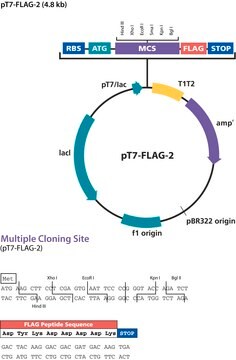M6693
Monoclonal Anti-MAT-Tag® antibody produced in mouse
purified immunoglobulin, ~2 mg/mL, clone MAT1-87
Sign Into View Organizational & Contract Pricing
All Photos(1)
About This Item
clone:
MAT1-87, monoclonal
application:
IP
WB
WB
technique(s):
immunoprecipitation (IP): 5-10 μg
western blot: 1-2 μg/mL
western blot: 1-2 μg/mL
citations:
5
Recommended Products
biological source
mouse
Quality Level
conjugate
unconjugated
antibody form
purified immunoglobulin
antibody product type
primary antibodies
clone
MAT1-87, monoclonal
concentration
~2 mg/mL
technique(s)
immunoprecipitation (IP): 5-10 μg
western blot: 1-2 μg/mL
isotype
IgG2a
shipped in
dry ice
storage temp.
−20°C
target post-translational modification
unmodified
Related Categories
General description
Monoclonal Anti-MAT (mouse IgG2a isotype) is derived from the MAT1-87 hybridoma produced by the fusion of mouse myeloma cells and splenocytes from BALB/c mice immunized with a synthetic MAT peptide HNHRHKHGGGC conjugated to KLH.
Monoclonal Anti-Mat-Tag® antibody was used in one-step purification of histidine-tagged fusion proteins under high pressure and high flow conditions. It is used in the characterization of the molecular architecture of human caveolin-3 and interaction with the skeletal muscle ryanodine receptor.
Specificity
Monoclonal Anti-MAT recognizes the seven amino acid MAT epitope sequence within either N or C terminal MAT-tagged fusion proteins.
Immunogen
synthetic MAT peptide HNHRHKHGGGC.
Application
Monoclonal Anti-MAT-Tag® antibody produced in mouse has been used in:
- enzyme linked immunosorbent assay (ELISA)
- immunoblotting
- immunoprecipitation
- immunocytochemistry
The MAT tag is a seven amino acid peptide tag that binds to transition metals such as Nickel and Cobalt. This tag, which consists of the sequence HNHRHKH, allows the purification of MAT fusion proteins using immobilized metal affinity chromatography (IMAC) such as the highly selective HIS-Select® Nickel Affinity Gel. The MAT tag sequence can be incorporated into both prokaryotic and eukaryotic expression vectors.
Physical form
Supplied as a solution in 0.01M phosphate buffered saline, pH 7.4, containing 15 mM sodium azide as a preservative.
Storage and Stability
For continuous use, store at 2-8 °C for up to one month. For extended storage freeze in working aliquots. Repeated freezing and thawing, or storage in "frost-free" freezers, is not recommended. If slight turbidity occurs upon prolonged storage, clarify the solution by centrifugation before use. Working dilution samples should be discarded if not used within 12 hours.
Legal Information
HIS-Select is a registered trademark of Merck KGaA, Darmstadt, Germany
MAT-Tag is a registered trademark of Merck KGaA, Darmstadt, Germany
Disclaimer
Unless otherwise stated in our catalog, our products are intended for research use only and are not to be used for any other purpose, which includes but is not limited to, unauthorized commercial uses, in vitro diagnostic uses, ex vivo or in vivo therapeutic uses or any type of consumption or application to humans or animals.
Not finding the right product?
Try our Product Selector Tool.
Storage Class Code
10 - Combustible liquids
WGK
nwg
Flash Point(F)
Not applicable
Flash Point(C)
Not applicable
Choose from one of the most recent versions:
Certificates of Analysis (COA)
Lot/Batch Number
Don't see the Right Version?
If you require a particular version, you can look up a specific certificate by the Lot or Batch number.
Already Own This Product?
Find documentation for the products that you have recently purchased in the Document Library.
The UV erythema action spectra of three coal tar preparations.
B Berne et al.
Clinical and experimental dermatology, 12(6), 400-402 (1987-11-01)
Jacob W Zyskind et al.
Journal of neurochemistry, 132(6), 742-755 (2014-10-04)
The transcription factor E2F1 activates gene targets required for G1 -S phase progression and for apoptosis, and exhibits increased expression levels in neurons in several CNS diseases including HIV encephalitis, Alzheimer disease, and Parkinson's Disease. While E2F1 is known to
Gareth Whiteley et al.
The Journal of biological chemistry, 287(48), 40302-40316 (2012-10-17)
Caveolin-3 facilitates both caveolae formation and a range of cell signaling pathways, including Ca(2+) homeostasis. Caveolin-3 forms a disc-shaped nonamer that binds the Ca(2+)-release channel, RyR1. Multiple caveolin-3 nonamers bind to a single RyR1 homotetramer. First three-dimensional structural insights into
Zhan-Peng Huang et al.
The Journal of clinical investigation, 125(11), 4122-4134 (2015-10-06)
Cardiomyopathy is a common human disorder that is characterized by contractile dysfunction and cardiac remodeling. Genetic mutations and altered expression of genes encoding many signaling molecules and contractile proteins are associated with cardiomyopathy; however, how cardiomyocytes sense pathophysiological stresses in
Our team of scientists has experience in all areas of research including Life Science, Material Science, Chemical Synthesis, Chromatography, Analytical and many others.
Contact Technical Service








